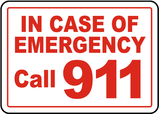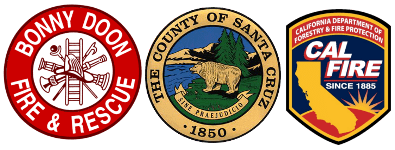Joining the Team
To become a volunteer firefighter, you must be at least 18 years of age. You must live within our primary response area. You must have a clean driving and criminal record. You must be in good physical condition, and be able to pass the CPAT physical ability test, a medical screening and a background check. Those are some of the legal requirements, but the real key is your sense of community, ability to communicate and work well with others in the sometimes high-stress environment of emergency response operations, and personal drive to help others. Can you take orders? Can you adapt and overcome obstacles? Can you function well under frustrating and life-threatening conditions? Can you maintain a sense of compassion under all circumstances? If so, then come to one of our Company drills, and we’ll talk.
Initial Training & Reporting Structure
Bonny Doon Volunteer Fire & Rescue is Santa Cruz County Fire Company 32. Santa Cruz County contracts CalFire to provide County Fire services, so our administration and training is provided by CalFire, whose CZU Unit Headquarters are in Felton. New volunteers go through a county Volunteer Fire Academy which is taught between February and April at the Ben Lomond Training Facility on Empire Grade. Upon completion of the academy and licensure as an EMR or EMT, volunteers are issued a pager and can begin responding to emergency calls in the community. After a year of responding, their status changes from “Trainee” to “Volunteer Firefighter I”, and they can begin the process of certification to drive the fire engines, and become a “Volunteer Firefighter II / Fire Apparatus Engineer”. Operationally, larger scenes of fires and vehicle accidents are under the command of a CalFire Battalion Chief, but volunteer Captains are of equal rank as CalFire Captains, volunteer Firefighters of equal rank as CalFire Firefighters. Ongoing classes and certifications are provided by CalFire’s Training Battalion, but Company drills are conducted by Company 32 itself the first Saturday Morning and Second and Third Tuesdays at 7pm.
Drills are conducted on a Company-wide basis three times each month. We typically meet at Martin (Station 32) on the first Saturday of each month from 9:00am to 1:00pm, and the second and third Tuesdays at McDermott (Station 34) from 6:00pm - 10:00pm. However, training schedules can change depending on what we're doing. You can check our shared calendar for more details https://bonnydoonfire.team/training or email [email protected]. Prospective volunteers are encouraged to email prior to attending first drill to ensure we include you in an any schedule changes/updates.
A typical Company training session starts with equipment check out. Engineers make sure the apparatus are in good working order, mechanically sound and fueled up. They also have to make sure the water tanks are full, the pumps operate properly, the communications equipment is functional, and the portable radios are charged.
Firefighters check out all the equipment carried on the apparatus. This includes the Self Contained Breathing Apparatus (SCBAs); hoses, fittings, and other fire-suppression tools; ladders, chainsaws and other ventilation and rescue equipment; the Jaws-Of-Life vehicle extrication tools; the rope rescue systems; and of course, the medical equipment.
Officers can take this time to take care of administrative duties, show guests around the station, or help out where needed. At some point house work is done to keep the station clean and organized, but following the fire service motto, “Many hands make light work,” this is soon completed, and we move on to the drill itself.
A topic for the monthly drills is assigned by the CalFire Training Battalion, but we can augment this with practice in both commonly and infrequently used skills. Typically we train on structural firefighting and medical aid in the fall and winter, and then focus on wildland firefighting, vehicle extrication and rope rescue in the spring and summer. This allows us to be prepared for what the typical “worst-case” call is for a given season.
Apart from attendance at Company Drills, volunteers must complete monthly online continuing education assignments, and periodic re-certification classes handled by CalFire’s Training Battalion to remain current. Through a combination of training, drills, and attendance on a minimum number of calls, volunteers keep their knowledge up to date and their skills in practice, so that they’re ready to respond when their pager goes off with whatever help might be needed.
Drills are conducted on a Company-wide basis three times each month. We typically meet at Martin (Station 32) on the first Saturday of each month from 9:00am to 1:00pm, and the second and third Tuesdays at McDermott (Station 34) from 6:00pm - 10:00pm. However, training schedules can change depending on what we're doing. You can check our shared calendar for more details https://bonnydoonfire.team/training or email [email protected]. Prospective volunteers are encouraged to email prior to attending first drill to ensure we include you in an any schedule changes/updates.
A typical Company training session starts with equipment check out. Engineers make sure the apparatus are in good working order, mechanically sound and fueled up. They also have to make sure the water tanks are full, the pumps operate properly, the communications equipment is functional, and the portable radios are charged.
Firefighters check out all the equipment carried on the apparatus. This includes the Self Contained Breathing Apparatus (SCBAs); hoses, fittings, and other fire-suppression tools; ladders, chainsaws and other ventilation and rescue equipment; the Jaws-Of-Life vehicle extrication tools; the rope rescue systems; and of course, the medical equipment.
Officers can take this time to take care of administrative duties, show guests around the station, or help out where needed. At some point house work is done to keep the station clean and organized, but following the fire service motto, “Many hands make light work,” this is soon completed, and we move on to the drill itself.
A topic for the monthly drills is assigned by the CalFire Training Battalion, but we can augment this with practice in both commonly and infrequently used skills. Typically we train on structural firefighting and medical aid in the fall and winter, and then focus on wildland firefighting, vehicle extrication and rope rescue in the spring and summer. This allows us to be prepared for what the typical “worst-case” call is for a given season.
Apart from attendance at Company Drills, volunteers must complete monthly online continuing education assignments, and periodic re-certification classes handled by CalFire’s Training Battalion to remain current. Through a combination of training, drills, and attendance on a minimum number of calls, volunteers keep their knowledge up to date and their skills in practice, so that they’re ready to respond when their pager goes off with whatever help might be needed.


